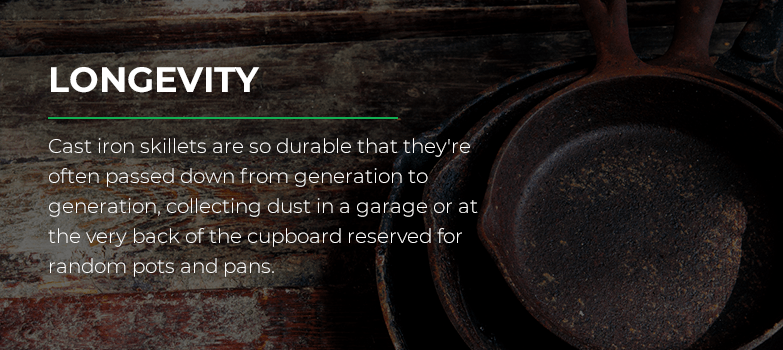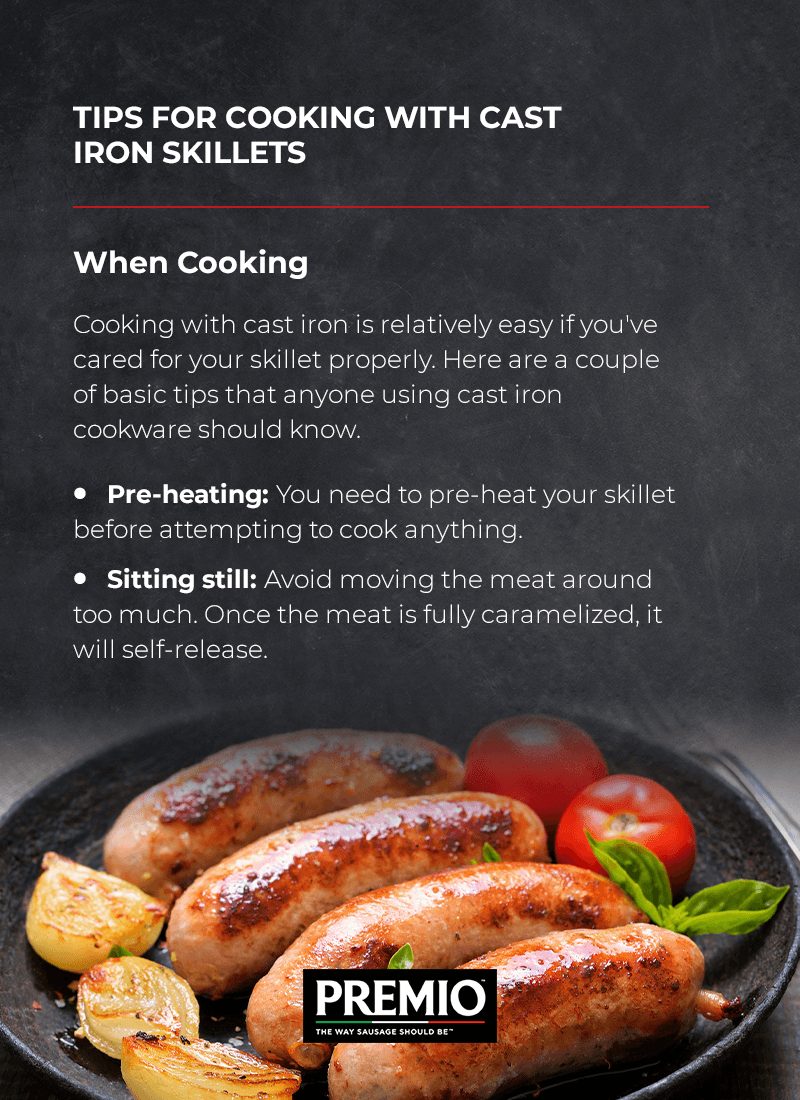Tips for Cooking With a Cast Iron Skillet
Nobody would blame you if you naturally gravitate towards the sleek, shiny non-stick pan while browsing the kitchen section of your local department store. It can handle your average fried egg with ease, and you don’t spend 20 minutes trying to scrape off any gross food residue. Somehow the remaining food particles of what you just ate is always ickier after being touched by water.
But you shouldn’t judge a book by its cover. You’ve probably had to deal with some of the less friendly features of a non-stick pan— an allergy to high heat, the inability to brown effectively or make simple glazes and the frustration that comes when non-stick suddenly becomes extra sticky.
You might be delighted to know that there is a solution, or at the very least, an alternative. Most modern-day cooks aren’t very familiar with cast iron cookware — if they’ve heard of it at all. It might be a surprise then to learn that a cast iron skillet could be what you were looking for all along.
What Is a Cast Iron Skillet?
Cast iron cookware was very popular in the United States for a long time. Until the 1940s, when aluminum cookware was first introduced, cast iron was widely revered. During the California Gold Rush in the mid-19th century, forty-niners used cast iron skillets to mine for gold. George Washington’s mother left him a cast iron in her will, and it’s still on display in the National Museum. Even Lewis and Clark listed the Dutch oven as being an essential piece of equipment on their explorations.
The historical value of cast iron cookware is immense. A cast iron skillet is made from iron, melted down and formed into pan-shaped molds called “casts.” The same base materials used to build engine blocks for internal combustion engines and the girders for bridges and frameworks of large structures are used to make cast iron. In other words, it’s heavy-duty.
Benefits of Using a Cast Iron Skillet
The benefits of cast iron skillets come from their rustic appeal. They are quite literally antique, but they aren’t delicate by any means nor rare enough to be worth millions. They don’t scratch, chip or melt. And unlike non-stick pans, they don’t simply wear out.
1. Longevity
Cast iron skillets are so durable that they’re often passed down from generation to generation, collecting dust in a garage or at the very back of the cupboard reserved for random pots and pans. Despite their ancient origins, they can be restored from virtually any condition. Do you have a cast iron skillet lying around somewhere? Tell us in the comments!
So if you have one handy, keep reading for some helpful cast iron cooking tips followed by some cast iron skillet recipes that complement this particular type of cookware handsomely.

2. Inexpensive
Cast iron skillets compete with some of the most expensive cookware there is. Stainless steel cookware, for example, has similar benefits to the cast iron skillets when it comes to heat but costs several hundred dollars. Even non-stick pans, often considered the cheap option, are around $100, if not more.
Cast iron skillets, on the other hand, are not expensive at all. The technology needed to make cast iron cookware is relatively low, which cuts cost quite a bit. A 10-inch skillet will cost between $10 and $15, and a 12-inch pan will cost between $15 and $20. If you don’t already have a cast iron skillet, getting one shouldn’t be difficult or expensive. You can get to cooking without having to worry about breaking the bank.
3. Heat Retention
Cooking with a typical frying pan can be delicate work. Everything’s fine on low to medium heat. But often, if you turn it up too high, you ruin the pan. You’re forced to look forward to an intensive scrape and wash every subsequent use.
Cast iron skillets can handle much higher heat. Cast iron absorbs and retains heat much more efficiently than your typical frying pan, which can also save you energy. Saving money on energy is one other benefit besides avoiding the turmoil of some overcooked grub. In retrospect, you’ll save enough to purchase a skillet in the first place.
Tips for Cooking With Cast Iron Skillets
A cast iron skillet comes with many benefits, but it requires proper care and needs a little affection. Using cast iron is worth the extra work, and it’s not too difficult. Here are a few tips that can keep your cast iron skillet in good condition without too much effort.
When Seasoning
Seasoning plays a crucial role in maintaining your cast iron skillet. A cast iron skillet doesn’t come non-stick. It may come with a coating if it’s brand new, but it won’t last forever. We use a process called seasoning to restore old, rusty pans or to prevent any future damage. Season your cast iron before first use. There are four steps in the seasoning process. The first and second steps only apply if this is your first time seasoning your skillet, and if that’s the case, it’s best to repeat the process twice.
- Scrub: Start by giving your pan a good scrub. Usually, steel wool is used for this. It’s slightly rugged but not overly abrasive. The objective is to scrub until you get to the cast iron’s base layer. Add in some hot water and a small amount of soap to help. Get the entire pan, including the handle, bottom, and sides. As long as its cast iron, it needs a scrubbing.
- Dry: You can use a towel to dry the skillet, but then place it in a hot oven or heat it on the stovetop. Cast iron rusts, so you want your skillet to be as dry as possible.
- Oil: This is where we get to the actual seasoning. Cover the whole pan with a thin layer of oil. You can pour a dollop of the oil in the pan and apply a paper towel or cloth to spread it around evenly. Since cast iron is porous, the oil will work to make the surface of your skillet smooth and slick. Wipe off any excess oil. It has the potential to leave your skillet sticky rather than non-stick.
- Heat: After your coat of oil is properly applied, you’ll finally get the chance to test the limits of your oven. Turn it up to the highest it can go and place the skillet inside, the bottom facing upwards. This should allow the oil to break down and bond with the cast iron. The skillet will remain sticky if the heat isn’t high enough. After an hour, turn off the oven and let the skillet cool.
When Cooking
Cooking with cast iron is relatively easy if you’ve cared for your skillet properly. Here are a couple of basic tips that anyone using cast iron cookware should know.
- Pre-heating: You need to pre-heat your skillet before attempting to cook anything. Cold food on a cold skillet does not mix well. Your food will stick, and that’s not what you want. Put the skillet on low or medium heat for five to 10 minutes. Hover a hand over the pan to feel whether it’s hot before adding anything to the pan.
- Sitting still: Don’t be too eager to flip that patty or sausage. Cooking meat on a cast iron skillet is like magic. It sticks until it doesn’t. Avoid moving the meat around too much. Once the meat is fully caramelized, it will self-release. Thanks, magic skillet!

When Cleaning
Proper cleaning is especially important if you’re working with cast iron. Rustic is one thing, but rusty isn’t exactly a positive description. The steps for cleaning mirror the steps for seasoning very closely.
- Don’t wait: Waiting too long before washing your cast iron skillet will be to your detriment. Food will stick to the pan if it gets too cool. This goes for most pans, really. Wash your skillet while it’s still warm to avoid having to soak it, which can cause rust.
- More scrubbing: Because you pre-seasoned your skillet, something as rough as steel wool is no longer needed. At this point, a reliable method of cleaning would be to use salt and hot water for a gentle scrubbing. With this method, you’ll avoid any damage to the seasoning.
- More drying: Like before with seasoning, it’s vital that your skillet is completely dry. Again, use a hand towel first. Afterward, heat it thoroughly using your oven or on top of the stove, depending on your preference. You don’t want any extra moisture haunting your precious skillet.
- More oiling: You’ll have to re-apply some oil to the skillet. A thin layer is always your best bet. This is a protective layer, so get rid of any excess. It’s less critical to cover the entire pan this time around, but be sure to get the inside of your skillet where the majority of your cooking gets done.
- More heating: Use your stovetop or oven once more to heat up to the oil. When it’s smoking, you’ll know it’s ready. This ensures the oil doesn’t turn rancid.
Great Recipes to Make With Your Cast Iron Skillet
Done seasoning your skillet? George Washingon’s mother would be proud! A seasoned cast iron skillet is best put to use immediately. There are plenty of recipes that can teach you how to use a cast iron skillet. If you’re craving something savory and delicious, try some of the recipes below. Make sure to find the right ingredients and follow the directions carefully.
Sausage and Spinach Skillet Pizza
The Sausage and Spinach Skillet Pizza is just what it sounds like. This dish should entice pizza-lovers. By using your cast iron skillet, you have the capability the recreate the cheesy goodness of a premium slice of pizza.

Buffalo Chicken Sausage Tater Tot Casserole
There seems to be a myth that casseroles should be boring and reserved for conservative dinner parties. Hopefully, the Buffalo Chicken Sausage Tater Tot Casserole can pull you away from the status quo. With chicken and tater tots in the same mouthful, this casserole could only be the opposite of boring.
Chef Capron’s Premio Sausage and Clams
For an easy, one-pot surf-and-turn meal, look no further than Chef Capron’s Premio Sausage and Clams. When you need delicate clams and bold sausage, this recipe will fill that need and then some.
Find Premio Sausages Near You
A cast iron skillet would be useless without the right foods to make the best use of its advantages. Italian sausage and a dependable recipe are all you need to make a dull day one to savor.
For nearly half a century, Premio Foods has been crafting fine-tailored Italian sausage to excite your and your family’s taste buds. We believe in family traditions, and our Italian sausages continue a family tradition. One of the best parts of belonging to a family is enjoying a cherished meal with your loved ones, and making sure that meal is exquisite is the best part of our job.
We offer mild Italian sausage, hot Italian sausage and sweet luganiga sausage if you’re more the traditional type. Those who appreciate international flavors can also find chorizo, bratwurst and kielbasa, among other things. Refined appetites will be pleased with our gourmet sausages — cheese and basil or pepper, onion and mushroom. Our chicken sausages offer the same Italian flavors with 60% less fat.
Whatever your preference may be, we have it. With over 40 varieties of sausage, you should have no trouble at all finding your personal favorite. Find Premio sausages near you, and you won’t be disappointed.


